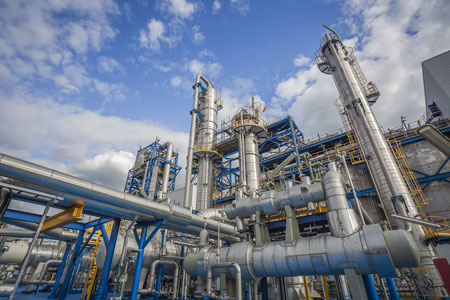
Hydrogen Sulfide Control with Hydrogen Peroxide
Hydrogen Sulfide Control with Hydrogen Peroxide
Refineries often face challenges with sulfur compounds like hydrogen sulfide, thiosulfates, and mercaptans in their wastewater. Hydrogen peroxide offers an effective solution for managing these, making it a cost-effective method for wastewater treatment.
Download our Refinery Sulfide Oxidation Brochure (pdf)
Understanding Hydrogen Sulfide
Hydrogen sulfide is problematic due to its strong odor, toxicity, and corrosiveness. Even at low concentrations (4 ppb), the smell can be noticeable and offensive. It’s also toxic, with prolonged exposure to levels over a few hundred ppm potentially causing unconsciousness or death.

Hydrogen sulfide is a byproduct of many refining processes. In wastewater systems, particularly during warm weather or high biological loading, bacteria can convert sulfates into hydrogen sulfide under anaerobic conditions. This process becomes more prevalent when oxygen levels are insufficient, leading to septic conditions.
Hydrogen peroxide reacts with hydrogen sulfide across different pH levels:
- Acidic/Neutral Conditions: Produces sulfur and water.
H2S + H2O2 → S + 2 H2O
Typically, this reaction requires a one-to-one weight ratio of hydrogen peroxide to hydrogen sulfide. However, extra peroxide may be needed due to other reactive materials in the wastewater.
- Alkaline Conditions (>pH 8): Produces sodium sulfate and water.
Na2S + 4 H2O2 → Na2SO4 + 4 H2O
The peroxide requirement can be decreased by combining it with air.
Addressing Other Sulfur Compounds
- Sulfites – Formed from sulfur dioxide and can increase oxygen demand in wastewater, leading to odors. Hydrogen peroxide oxidizes sulfites to sulfates efficiently, especially at lower pH levels.
- Thiosulfates – Thiosulfate wastes can be generated as products of petroleum refining. The product of the reaction between hydrogen peroxide and thiosulfate is dependent on pH and catalysts.
- Alkaline Conditions (pH >8): Hydrogen peroxide converts thiosulfates to sulfates without a catalyst. Reaction time can be reduced with metal catalysts.
- pH 4-8: Without catalysts, thiosulfates become tetrathionates. With metal catalysts, they convert to sulfates.
Treating Mercaptans and Dialkyl Sulfides
- Mercaptans (RSH) – undergo oxidation forming disulfides and water. The oily disulfides can be easily separated from the liquid.
- 2 RSH + H2O2 → RSSH + 2 H2O
- Dialkyl Sulfides (RSR) also oxidize similarly.
Phenols
Phenolic compounds from refineries can be toxic to aquatic life. Biological systems can treat phenols, but are vulnerable to shock loading and cold temperatures. Hydrogen peroxide, especially when used with iron salts (Fenton’s Reagent), can rapidly oxidize phenols, breaking them down into harmless components like carbon dioxide and water.
For effective phenol removal, a typical weight ratio of 3/1 hydrogen peroxide to phenol suffices. Many substituted phenols also respond well to similar treatments.
Conclusion
Hydrogen peroxide proves to be a versatile and efficient agent for managing sulfur compounds and phenols in refinery wastewater. Contact us today to learn how USP can help support your system.
Contact Us
Contact Us Form
"*" indicates required fields
USP Technologies
5640 Cox Rd.
Glen Allen, VA 23060
Toll-free (800) 851-8527
Phone (804) 404-7696
USP - Canada
3020 Gore Road
London, Ontario N5V 4T7
Toll-free (800) 851-8527
Phone (804) 404-7696
Contact Us
Our sales engineers are ready to help you find the right solution. Fill out the form to connect with your local USP Technologies representative.
"*" indicates required fields